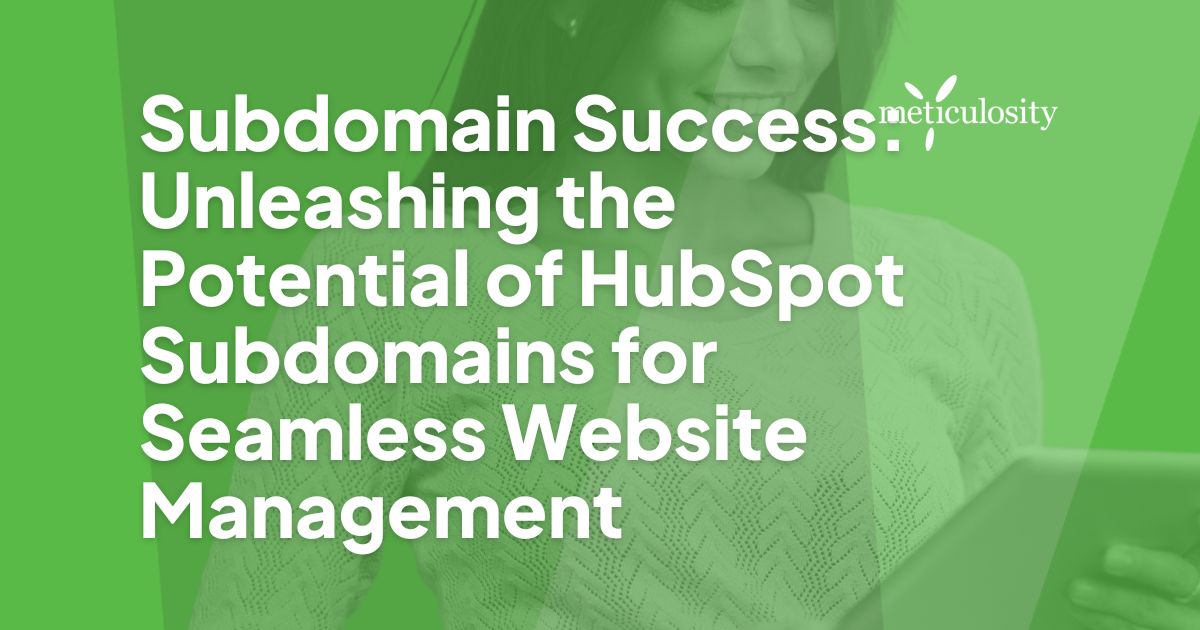Have you ever felt overwhelmed with managing your website on HubSpot, especially regarding the nitty-gritty of subdomains? It's completely normal! The ins and outs of domain management can feel like a twisting maze.
But here's some good news: the best use of HubSpot Subdomains can make your website operations more smoothly. This article will explore how leveraging a Subdomain in HubSpot simplifies website management and paves the way for untapped marketing opportunities.
Key Takeaways
- HubSpot subdomains simplify website management by allowing you to create unique sections within your main website domain.
- Using subdomains in HubSpot offers benefits such as improved customization options and enhanced SEO.
- Setting up a subdomain in HubSpot involves registering a domain and following a step-by-step guide for connecting the subdomain.
- When choosing a subdomain for your HubSpot account, prioritize relevance, branding, and easy rememberability.
What is a HubSpot Subdomain?
A HubSpot subdomain is a part of your main website. It leads to a different section of your site. Think of it like a room in your house. Your home address gets people to your house, but the name on the door tells them which room to enter.
In the online world, "hubspot.com" could be our main website or "house." A subdomain lets us create unique pages such as "blog.hubspot.com," which would lead you right into our blog or "room.".
You can use HubSpot's tools for making and managing subdomains very easily. This helps you keep everything neat and tidy under one roof – that is, inside one major domain! You get better control over how parts of your site work and who sees what content.
So, each piece of your web space has its own clear job to do!
Benefits of Using a Subdomain in HubSpot
Using a subdomain in HubSpot offers several advantages, including enhanced website management capabilities and improved customization options.
Definition and Advantages of Subdomains
A subdomain is part of your main website domain. You see it as a new web address under your main domain. It works like a mini-website for you on the big site. This small site has its content and goals.
The best part is that creating one costs nothing extra! Subdomains help you to manage different parts of your website easily. They also boost SEO because search engines read them as separate sites.
So they can rank higher on their own or bring more traffic to the main site if well managed.
How Subdomains Enhance HubSpot Experience
HubSpot subdomains boost your website in many ways. They let you divide your site into sections. Each section can have a different focus. You could have one for blogs and another for sales, for example.
This makes your content easy to find and understand. It also helps with the search engine rankings of your pages (SEO). Plus, you can customize each subdomain to suit its topic or target market.
So, using HubSpot's tools, a subdomain might look unique while linking to your main site.
Looking to optimize HubSpot for your business? Learn how to improve here.
How to Set Up a Subdomain in HubSpot
To set up a subdomain in HubSpot, you must first register a domain and then follow the step-by-step guide for connecting your subdomain.
Registering a Domain
You must first register a domain to set up a subdomain in HubSpot. A domain is the web address that people use to find your website. It's like the street address for your online home.
When choosing a domain, picking something relevant and easy to remember is important. You can register a domain through various providers, such as GoDaddy or Namecheap. Once you have registered your desired domain, you can then connect it to your HubSpot account following the step-by-step guide provided by HubSpot.
This will allow you to create and manage subdomains within HubSpot for seamless website management.
Step-by-Step Guide for Connecting Subdomains
Setting up subdomains in HubSpot is a straightforward process. Follow these steps to connect your subdomains seamlessly:
- Register a domain: Before creating a subdomain, you need to register a domain name. Choose a domain that aligns with your brand and represents your business effectively.
- Access HubSpot settings: Log in to your HubSpot account and navigate to the settings menu.
- Select Domains & URLs: Find the "Domains & URLs" section in the settings menu.
- Click on "Manage domains": Under Domains & URLs, click "Manage domains" to access the domain manager.
- Add your domain: Click the "+ Add custom domain" button in the domain manager.
- Enter the subdomain name: Provide the desired subdomain name in the designated field (e.g., blog.yourdomain.com).
- Configure SSL certificate: Enable an SSL certificate for your subdomain by selecting whether you want HubSpot's free certificate or prefer your existing certificate.
- Verify DNS settings: HubSpot will provide you with DNS records that must be added to your domain's DNS settings via your hosting provider.
- Update DNS settings: Log into your hosting provider's website and locate the DNS settings for your domain. Add the provided DNS records accurately.
- Validate setup: Once you've updated the DNS records, return to HubSpot and click on "Verify Domain Setup." HubSpot will check if everything is set up correctly.
- Set as default hub domain (optional): If desired, make your newly connected subdomain the default hub domain for landing pages, blog posts, and other content in HubSpot.
Choosing the Right Subdomain for Your HubSpot Account
When selecting a subdomain for your HubSpot account, it is crucial to prioritize relevance and branding to ensure a seamless user experience and maximize the impact of your marketing efforts.
Importance of a Relevant and Branded Subdomain
A relevant and branded subdomain for your HubSpot account is crucial for your website's success. A subdomain that aligns with your brand helps create a cohesive online presence, making it easier for visitors to recognize and remember your website.
It also adds credibility to your business by showcasing professionalism and attention to detail. When choosing a subdomain, ensure it relates directly to what you offer or your industry.
This helps potential customers understand what they can expect from your website immediately. By selecting a relevant and branded subdomain, you demonstrate that you take your online presence seriously and are committed to providing valuable content or services to your audience.
Tips for Choosing a Subdomain
When choosing a subdomain for your HubSpot account, a few tips can help you make the right decision. Here are some things to consider:
- Keep it relevant: Choose a subdomain related to your business or industry. This will make it easier for visitors to remember and understand what your website is about.
- Make it branded: Use your company's name or a variation of it as your subdomain. This helps reinforce your brand and makes your website more recognizable.
- Keep it short and simple: Long subdomains can be difficult to type and remember. Aim for something concise and easy to spell.
- Consider keywords: If possible, include relevant keywords in your subdomain. This can help with search engine optimization (SEO) and improve your website's visibility in search results.
- Check availability: Before finalizing your subdomain, ensure another company or website does not already use it. You want to avoid confusion or legal issues.
Customize landing pages and forms on your HubSpot subdomain to create a seamless user experience that aligns with your branding.
Customizing Landing Pages and Forms
Customizing landing pages and forms in HubSpot is an essential aspect of utilizing subdomains effectively for your website. Here are some key ways you can customize these elements to enhance your marketing efforts:
- Create visually appealing landing pages: Use the intuitive drag-and-drop interface in HubSpot to design attractive landing pages that align with your brand. Choose from various templates and customize them to meet your specific requirements.
- Personalize forms: Customize the fields and layout of your forms to collect the information you need from your leads. Ensure that the form reflects your branding and is easy for visitors to fill out.
- Optimize for mobile: With the majority of internet users accessing websites on their mobile devices, it's crucial to ensure that your landing pages and forms are mobile-friendly. HubSpot provides responsive design options that automatically adapt to different screen sizes.
- Implement conversion-friendly elements: Use compelling call-to-action (CTA) buttons, persuasive copywriting, and relevant images or videos to increase conversions on your landing pages. Experiment with different elements to see what resonates most with your audience.
- A/B testing: Take advantage of HubSpot's A/B testing feature to experiment with different variations of your landing pages and forms. This allows you to identify which designs, copy, or form fields perform best, helping you optimize for higher conversion rates.
Using Subdomain Analytics
To maximize the effectiveness of your HubSpot subdomain, it's important to utilize analytics tools. These tools allow you to monitor and analyze the performance of your subdomain, giving you valuable insights into its success and areas for improvement.
With subdomain analytics, you can track website traffic, identify which pages are performing well, and understand user behavior on your site. This information can help guide your marketing strategies and optimize the content on your subdomain.
By regularly monitoring and analyzing these metrics, you can make data-driven decisions to enhance the performance of your HubSpot subdomain.

Monitoring and Optimizing Performance of Your Subdomain
To ensure the success of your HubSpot subdomain, it is crucial to actively monitor and optimize its performance by tracking website traffic and implementing effective SEO strategies.
Tracking Website Traffic
Tracking website traffic is crucial to managing your HubSpot subdomain and maximizing its potential effectively. By monitoring the number of visitors coming to your site, you can gain valuable insights into the effectiveness of your marketing efforts.
You can easily track important metrics such as page views, unique visitors, bounce, and conversion rates using HubSpot's built-in analytics tools.
With this information, you can identify which pages on your subdomain are performing well and which ones may need improvement. You'll also be able to see where your traffic is coming from – whether it's through search engines, social media platforms, or direct visits.
This data allows you to make data-driven decisions when it comes to optimizing your subdomain and driving more targeted traffic.
By regularly tracking website traffic on your HubSpot subdomain, you can continuously improve its performance by implementing strategies that align with what works best for attracting and engaging visitors.
Implementing SEO Strategies
To maximize the potential of your HubSpot subdomain, there are a few key SEO strategies that you should implement. These strategies will help increase your website's visibility and attract organic traffic. Here are some tips to get started:
- Keyword Research: Conduct thorough keyword research to identify relevant and high-ranking keywords in your industry. Use these keywords strategically throughout your subdomain content to improve search engine rankings.
- On-Page Optimization: Optimize your subdomain webpages by including target keywords in page titles, headings, meta tags, and image alt texts. This will make it easier for search engines to understand what your pages are about.
- Quality Content Creation: Create valuable, informative content that resonates with your target audience. Focus on providing answers to their questions and addressing their pain points. High-quality content improves SEO, keeps visitors engaged, and encourages them to stay longer on your subdomain.
- Link Building: Build a strong network of backlinks from reputable websites within your industry. Contact other websites for guest blogging opportunities or collaborate on content creation. Each backlink is like a vote of confidence for search engines, improving the authority of your subdomain.
- Mobile-Friendly Design: Ensure that your subdomain is optimized for mobile devices as well. With increasing users accessing websites through mobile devices, a responsive design is crucial for SEO performance.
- Page Speed Optimization: Improve the loading speed of your subdomain by optimizing images, minimizing HTML and CSS files, and using caching plugins if applicable. A faster-loading website improves user experience and boosts search engine rankings.
Common Mistakes to Avoid When Setting Up a HubSpot Subdomain
When setting up a HubSpot subdomain, avoiding common mistakes such as duplicate content and poor domain structure is crucial.
Duplicate Content
Duplicate content refers to having the same or similar content on multiple website pages. This can negatively impact your search engine rankings because it confuses search engines and makes it difficult for them to determine which page is the most relevant.
To avoid duplicate content issues, ensure each page on your subdomain has unique and valuable content. You can also use canonical tags or 301 redirects to indicate which version of a page should be indexed by search engines.
Regularly auditing and updating your site's content can help you identify and resolve duplicate content problems, ensuring your subdomain performs at its best.
Poor Domain Structure
Poor domain structure can negatively impact your website's performance when setting up a HubSpot subdomain. It's essential to carefully plan and organize your subdomains to ensure smooth navigation for your visitors.
Poor domain structure can lead to confusion, making it difficult for users to find the necessary information. This can result in higher bounce rates and lower conversions. By organizing your subdomains logically and intuitively, you can improve the user experience and make it easier for visitors to explore different website sections.
So, take the time to think about how you want to structure your subdomains and create a clear hierarchy that aligns with your content strategy.
In addition, having poor domain structure affects the user experience and search engine optimization (SEO). Search engines rely on structured URLs and sitemaps to index websites effectively.
If your subdomains are disorganized or have duplicate content, search engines may struggle to understand which pages are most important or relevant. This can negatively impact your rankings in search results.
Best Practices for Managing a HubSpot Subdomain
Regularly updating content on your HubSpot subdomain is crucial for maintaining a dynamic and engaging website.
Regularly Updating Content
Regularly updating your content is crucial for maintaining a successful HubSpot subdomain. By consistently adding fresh and relevant information, you keep your audience engaged and attract new visitors.
Updating content can include publishing blog posts, adding new web pages, or refreshing existing ones with updated information. It's best to regularly review and optimize your content for search engines to ensure it remains visible and drives traffic to your site.
Additionally, staying up-to-date with industry trends and customer needs can provide valuable insights that establish you as an authoritative source in your field. So, make it a priority to update your content regularly to maintain the effectiveness of your HubSpot subdomain and drive continued success for your website.
Integrating with Other Platforms
Integrating your HubSpot subdomain with other platforms can enhance your website management and marketing efforts. Here are some ways you can integrate your subdomain:
- Seamless CRM Integration: Connect your HubSpot subdomain with your customer relationship management (CRM) system to streamline lead generation and customer data management.
- Social Media Integration: Integrate your subdomain with social media platforms like Facebook, Instagram, or LinkedIn to enhance social sharing and track engagement on these channels.
- Email Marketing Integration: Use your subdomain to connect with email marketing platforms such as Mailchimp or Constant Contact, enabling you to manage and track email campaigns effectively.
- Ecommerce Integration: If you have an online store, integrate your subdomain with popular ecommerce platforms like Shopify or WooCommerce to create a seamless customer shopping experience.
- Analytics Integration: Connect your HubSpot subdomain with tools like Google Analytics or Adobe Analytics for comprehensive website tracking and performance analysis.
- Content Management System (CMS) Integration: Integrate your subdomain with CMS platforms like WordPress or Drupal for easy content creation, publishing, and management.

Conclusion
In conclusion, utilizing HubSpot subdomains can significantly enhance your website management experience. Registering a relevant and branded subdomain allows you to customize landing pages, track website traffic, and implement effective SEO strategies.
Avoid common mistakes like duplicate content and poor domain structure to ensure the success of your HubSpot subdomain. Follow best practices such as regularly updating content and integrating with other platforms for optimal results.
With the right approach, you can unleash the full potential of HubSpot subdomains for seamless website management.
Click here to learn more about HubSpot marketing.
FAQs
1. What is a HubSpot subdomain, and how is it used in website hosting?
A HubSpot subdomain is a domain that is part of a larger primary domain within the HubSpot Content Management System (CMS). It is often used to host specific sections or types of content separate from the main website. For example, blog.yourdomain.com or shop.yourdomain.com could be subdomains in HubSpot. This modular approach allows for better organization and management of different content types.
2. How can I set up a subdomain in HubSpot, and what steps are involved?
-
Access Domain Manager: Go to "Settings" in your HubSpot account and select "Domains & URLs."
-
Add Subdomain: Click "Add a domain or subdomain" and choose "Subdomain." Enter the desired subdomain and follow the prompts to configure DNS settings.
-
Verify Ownership: Complete the necessary steps to verify ownership of the subdomain, typically updating your domain's DNS records.
-
Configure Content: Once verified, configure the subdomain's content settings, including templates, pages, and modules associated with the subdomain.
3. Can I use multiple subdomains in HubSpot, and are there any limitations?
You can use multiple subdomains in HubSpot to organize and structure your content effectively. Each subdomain can have its own set of templates, pages, and modules. However, it's important to consider the following limitations:
-
SSL Certificates: Each subdomain requires its own SSL certificate for secure connections. Ensure that SSL is properly configured for each subdomain.
-
Content Syncing: Content is not automatically synced between subdomains. If you have shared content, you may need to duplicate it or use global content modules for consistency.
-
HubSpot Plan: The availability of subdomains may vary based on your HubSpot plan. Check your subscription to ensure it supports the number of subdomains you need.
4. How does using subdomains impact SEO and website performance in HubSpot?
-
SEO Considerations: When properly configured, subdomains can be SEO-friendly, especially when used to organize distinct sections of content. Search engines treat subdomains as separate entities, so choose a structure that aligns with your SEO strategy.
-
Site Performance: HubSpot's CDN (Content Delivery Network) is designed to optimize site performance, including subdomains. Ensure that assets and content are efficiently cached and delivered for optimal loading times.
-
Backlinks and Authority: Subdomains may have separate backlink profiles, so consider the impact on domain authority. Properly structured subdomains can contribute positively to SEO efforts.
It's recommended to consult with your SEO and web development teams when implementing subdomains to ensure the chosen structure aligns with your overall digital strategy and best practices.







